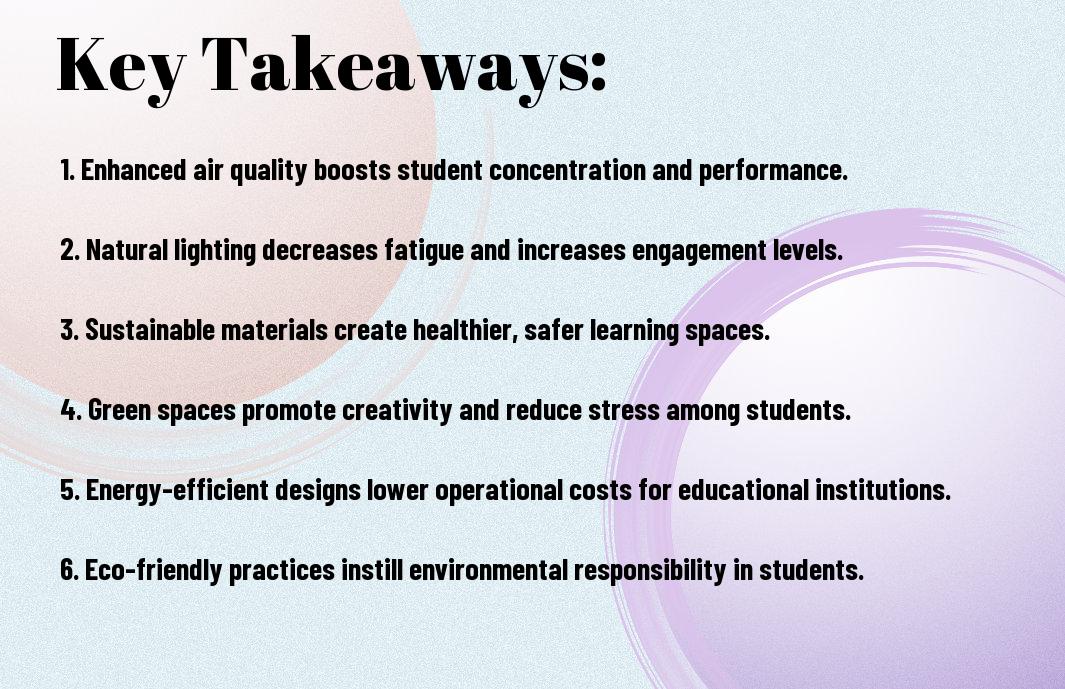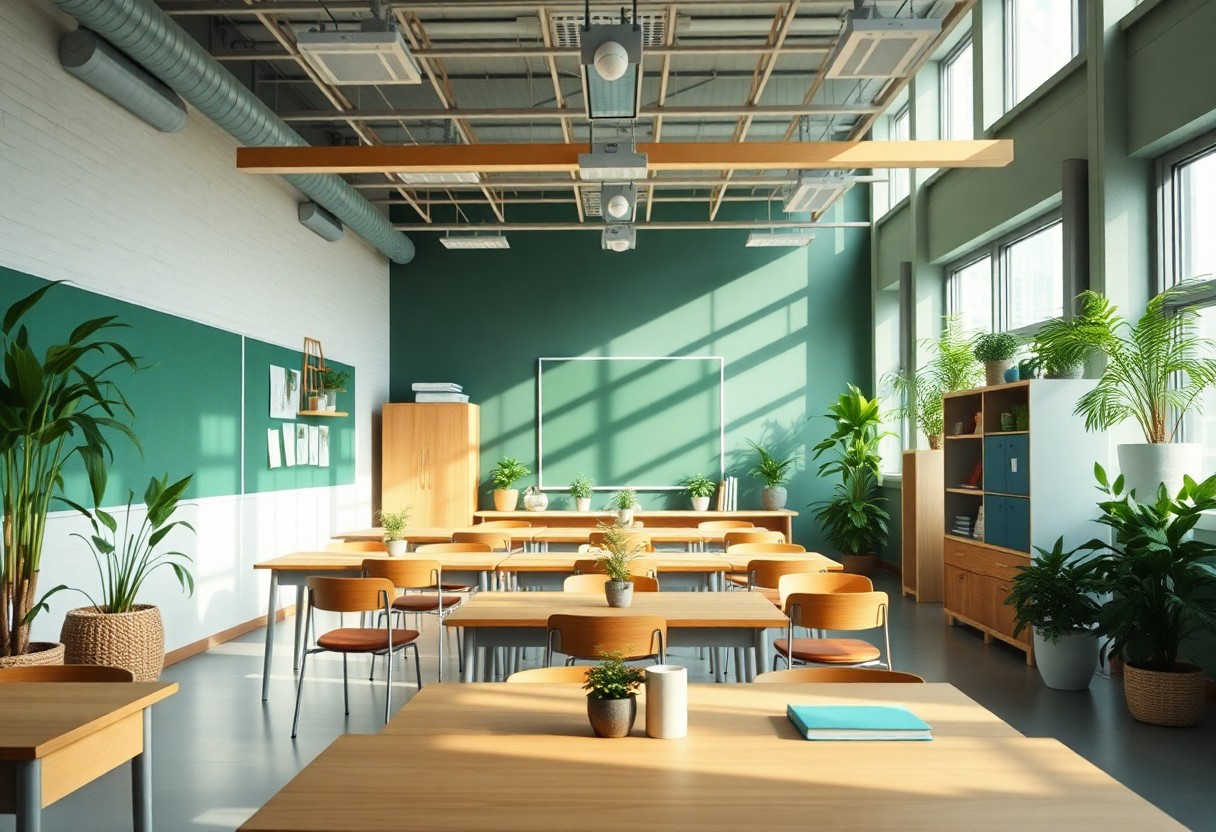As you consider ways to enhance your learning space, you may be surprised by the impact of green products on the educational experience. You can create a healthier and more productive environment by incorporating eco-friendly materials and products into your classroom or study area. By doing so, you will not only be supporting sustainability, but also improving the overall well-being and focus of your students, which can lead to better learning outcomes and a more positive experience for everyone involved.
Key Takeaways:
To enhance learning environments, incorporating green products can have a significant impact. Here are a few key points to consider:
- Using sustainable materials in educational settings can improve air quality, which in turn enhances student health and productivity.
- Energy-efficient solutions, such as LED lighting and solar panels, can reduce energy consumption and lower operational costs, allowing for more resources to be allocated towards educational programs and student development.
- Implementing eco-friendly products and practices can foster a sense of community and environmental awareness among students, encouraging them to adopt sustainable lifestyles and develop a deeper appreciation for the natural world.

Benefits of Green Products
The incorporation of green products in learning environments can have a significant impact on your students’ well-being and academic performance. By choosing eco-friendly options, you can create a healthier and more sustainable space for your students to learn and grow.
Improved Air Quality
Products like air purifiers and natural cleaning supplies can greatly improve the air quality in your classroom, reducing the presence of toxins and pollutants that can hinder your students’ ability to focus and learn.
Enhanced Student Health
Above all, using green products can help prevent the spread of illnesses and allergies, creating a healthier environment for your students to thrive in. You can expect to see a decrease in absenteeism and an increase in overall student well-being.
With the implementation of green products, you can also expect to see a reduction in respiratory problems and other health issues that can be exacerbated by poor air quality. Your students will be able to breathe easier, focus better, and perform at their best, thanks to the healthier environment you’ve created for them.

Sustainable Learning Environments
Assuming you want to create an optimal learning space, incorporating green products is a great way to start. You can improve the overall ambiance and productivity of your learning environment by adopting sustainable practices and products.
Energy-Efficient Solutions
For instance, you can invest in energy-efficient lighting and heating systems to reduce your carbon footprint. You will not only contribute to a healthier planet, but also save on your energy bills.
Eco-Friendly Materials
By choosing eco-friendly materials for your learning space, you can create a healthier and more sustainable environment. You can opt for recycled furniture, natural flooring, and non-toxic paints to minimize your impact on the environment.
Another benefit of using eco-friendly materials is that they can improve the air quality in your learning space. You can reduce exposure to harmful chemicals and pollutants, creating a safer and more comfortable environment for you to focus and learn.
Psychological Impact of Green Spaces
Not only do green products improve the physical learning environment, but they also have a profound impact on your mental well-being. By incorporating green spaces into your learning environment, you can experience a range of psychological benefits that enhance your overall learning experience.
Boosted Mood and Productivity
One of the most significant advantages of green spaces is their ability to boost your mood and productivity. You will find that being surrounded by green products can increase your focus and energy, allowing you to stay motivated and engaged in your learning.
Reduced Stress and Anxiety
With the presence of green spaces, you will experience a significant reduction in stress and anxiety. You will feel more calm and relaxed, which can lead to improved mental health and well-being.
In addition, as you spend more time in green spaces, you will notice a decrease in your stress levels and anxiety, allowing you to better cope with the demands of learning and achieve your academic goals. By creating a peaceful and calming environment, you can improve your overall learning experience and reach your full potential.
Incorporating Green Products in Schools
After implementing green products in your school, you will notice a significant improvement in the learning environment. You can start by replacing traditional cleaning products with eco-friendly ones and using recycled materials for decorations and supplies. This will not only reduce your school’s carbon footprint but also promote a healthier environment for your students.
Affordable Options and Initiatives
Around the country, schools are finding creative ways to incorporate green products without breaking the bank. You can explore options like buying in bulk, shopping during sales, or partnering with local organizations that offer discounts on eco-friendly products. By doing so, you can create a more sustainable learning environment without overspending.
Community Involvement and Education
On top of incorporating green products, you can also educate your students about the importance of sustainability. You can organize workshops, seminars, or even field trips to teach your students about the benefits of going green. This will not only help your students develop a sense of responsibility but also encourage them to make eco-friendly choices in their daily lives.
Another way to promote community involvement and education is by engaging with local businesses and organizations that share your commitment to sustainability. You can partner with them to develop educational programs, host events, or even launch initiatives that promote eco-friendly practices in your community. By working together, you can create a ripple effect that inspires others to join the green movement and makes a positive impact on the environment.
Innovative Green Technologies
Once again, you will find that innovative green technologies play a significant role in improving learning environments. You can integrate various green technologies into your educational setting to promote sustainable development and reduce environmental impact.
Smart Classrooms and Labs
The incorporation of smart classrooms and labs enables you to create interactive and engaging learning experiences. You will be able to use digital tools and multimedia resources to enhance your teaching methods and make your lessons more effective.
Renewable Energy Systems
Smart investments in renewable energy systems, such as solar and wind power, can significantly reduce your reliance on non-renewable energy sources. You will be able to power your educational facilities in a sustainable and environmentally friendly manner.
Energy efficiency is a key benefit of renewable energy systems, allowing you to reduce your energy consumption and lower your utility bills. You can use the saved funds to invest in other areas of your educational institution, such as upgrading your infrastructure or providing additional resources for your students. By adopting renewable energy systems, you will not only be reducing your environmental impact but also contributing to a more sustainable future for your community.
Challenges and Limitations
Unlike traditional learning environments, green schools face unique obstacles, including higher upfront costs and the need for specialized maintenance, which can be daunting for you as you consider making the switch to a more sustainable learning space.
Implementation Costs and Barriers
Around the time you start planning your green school initiative, you will encounter various barriers, including lack of funding, insufficient infrastructure, and limited access to green products, all of which can hinder your progress and force you to reevaluate your priorities.
Balancing Sustainability and Budget
At the forefront of your decision-making process, you must weigh the environmental benefits of green products against the financial constraints of your institution, as you strive to create a learning environment that is both sustainable and affordable for your students.
Challenges associated with balancing sustainability and budget can be significant, and you will need to carefully consider your options, prioritize your spending, and explore creative solutions, such as grants, partnerships, or phased implementation, to ensure that your green school initiative is both effective and financially viable, ultimately benefiting you and your students in the long run.
Summing up
Considering all points, you can see how green products enhance your learning environment. By incorporating eco-friendly materials, you create a healthier space that boosts productivity. For more insights, visit The Green Classroom: Sustainable Practices For Eco-Friendly Learning to discover innovative ways to transform your space, ultimately improving your overall learning experience.
FAQ
Q: What are green products and how do they contribute to improving learning environments?
A: Green products are environmentally friendly materials and supplies that are designed to reduce harm to the environment and promote sustainability. In learning environments, such as schools and universities, green products can contribute to improved air quality, reduced waste, and enhanced overall health and well-being of students and staff. By using green products, educational institutions can create a healthier and more sustainable learning environment that supports the academic success and development of their students.
Q: How do green products improve indoor air quality in learning environments?
A: Green products, such as low-VOC (volatile organic compound) paints, natural flooring, and energy-efficient ventilation systems, can significantly improve indoor air quality in learning environments. These products reduce the emission of harmful chemicals and pollutants, creating a cleaner and healthier breathing environment for students and staff. Improved indoor air quality has been linked to improved cognitive function, reduced absenteeism, and enhanced overall health and well-being.
Q: Can green products help reduce distractions and improve student focus in the classroom?
A: Yes, green products can help reduce distractions and improve student focus in the classroom. For example, using natural light and installing acoustic panels can minimize echo and distractions, creating a more conducive learning environment. Additionally, incorporating plants and natural elements into the classroom design can help reduce stress and improve student engagement. By creating a calm and focused learning environment, green products can help students stay on task and achieve their academic goals.
Q: How can educational institutions incorporate green products into their existing infrastructure?
A: Educational institutions can incorporate green products into their existing infrastructure in a variety of ways, such as replacing traditional lighting with energy-efficient LED bulbs, installing recycling programs, and using eco-friendly cleaning supplies. Schools can also consider renovating existing buildings with sustainable materials, such as reclaimed wood and low-VOC paints, or incorporating green roofs and walls into their design. By making these changes, educational institutions can reduce their environmental footprint and create a healthier and more sustainable learning environment.
Q: What are the long-term benefits of using green products in learning environments?
A: The long-term benefits of using green products in learning environments are numerous and significant. By creating a healthier and more sustainable learning environment, educational institutions can improve student academic performance, reduce absenteeism, and enhance overall health and well-being. Additionally, green products can help reduce energy consumption and lower maintenance costs, resulting in long-term cost savings for the institution. By investing in green products, educational institutions can create a positive and supportive learning environment that benefits both students and the environment for years to come.